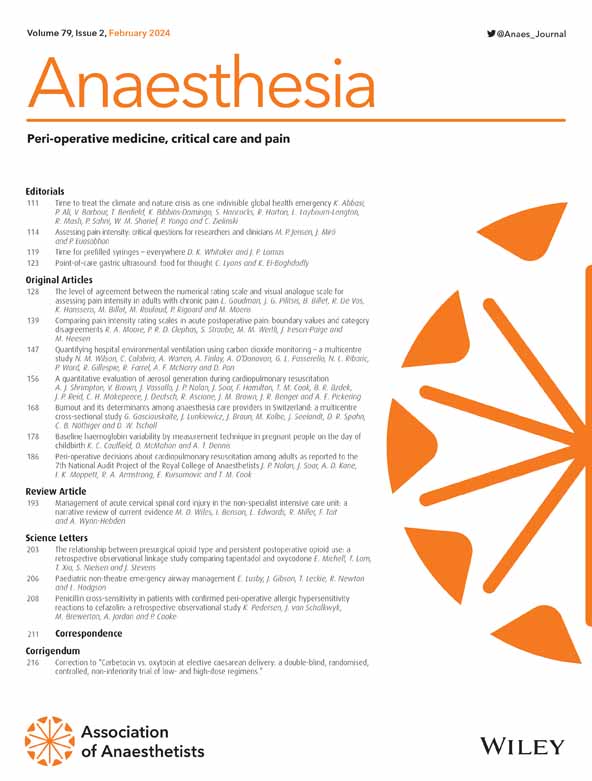英国生物库中腹部手术后慢性疼痛的全基因组关联研究
IF 7.5
1区 医学
Q1 ANESTHESIOLOGY
引用次数: 0
摘要
慢性疼痛是手术后最常见和最严重的并发症之一,影响患者的生活质量和整体健康。已经确定了几个危险因素,但慢性术后疼痛发展的机制仍不清楚。本研究旨在确定与腹部手术后慢性术后疼痛相关的单核苷酸多态性,腹部手术是最常见的手术类型之一。方法对来自UK Biobank接受腹部手术的27,603例患者进行全基因组关联研究。鉴定的基因座的稳健性通过对半验证分析进行验证。选择功能相关的顶部基因座,在有疼痛和无疼痛的粘连患者的临床样本中进行表达验证。结果1个位点(rs185545327)与慢性术后疼痛发展的相关性达到全基因组显著性,10个位点超过了提示性显著阈值(p <;1 × 10‐6)。在稳健性分析中,8个位点至少具有名义显著性。通过暗示显著阈值的位点被定位到15个基因,其中两个位点包含疼痛相关基因(SRPK2, PDE4D)。虽然在临床样本的表达验证中,PDE4D的检出率和表达水平在疼痛患者中与对照组相比略有接近统计学意义,但PDE4D在疼痛患者中的检出率和表达水平略高于对照组。本研究为腹部手术后慢性术后疼痛的遗传风险因素提供了初步证据,特别是PDE4D基因,该基因在之前的研究中与疼痛有关。这一发现进一步证明了个性化风险预测的临床应用工具的未来发展潜力,帮助临床医生对患者进行分层,并通过个性化风险评估加强临床决策。本文章由计算机程序翻译,如有差异,请以英文原文为准。
Genome‐wide association study on chronic postsurgical pain after abdominal surgeries in the UK Biobank
SummaryIntroductionChronic pain is one of the most common and severe complications after surgery, affecting quality of life and overall wellbeing of patients. Several risk factors have been identified but the mechanisms of chronic postsurgical pain development remain unclear. This study aimed to identify single‐nucleotide polymorphisms associated with developing chronic postsurgical pain after abdominal surgery, one of the most common types of surgery.MethodsA genome‐wide association study was performed on 27,603 patients from the UK Biobank who underwent abdominal surgery. The robustness of identified loci was validated by split‐half validation analysis. Functionally related top loci were selected for expression validation in clinical samples of adhesions from patients with and without pain.ResultsOne locus (rs185545327) reached genome‐wide significance for association with chronic postsurgical pain development, and 10 loci surpassed the suggestively significant threshold (p < 1 × 10‐6 ). In the robustness analysis, eight loci had at least nominal significance. The loci passing the suggestively significant threshold were mapped to 15 genes, of which two loci contained pain‐related genes (SRPK2 , PDE4D ). Although marginally approaching statistical significance in the expression validation of clinical samples, the detection rate and expression level of PDE4D were modestly higher in patients with pain compared with those in the control group.DiscussionThis study provides preliminary evidence for genetic risk factors implicated in chronic postsurgical pain following abdominal surgery, particularly the PDE4D gene, which has been associated with pain in previous studies. The findings add to evidence suggesting potential for the future development of a clinically applicable tool for personalised risk prediction, aiding clinicians in stratifying patients and enhancing clinical decision‐making through individualised risk assessments.
求助全文
通过发布文献求助,成功后即可免费获取论文全文。
去求助
来源期刊

Anaesthesia
医学-麻醉学
CiteScore
21.20
自引率
9.30%
发文量
300
审稿时长
6 months
期刊介绍:
The official journal of the Association of Anaesthetists is Anaesthesia. It is a comprehensive international publication that covers a wide range of topics. The journal focuses on general and regional anaesthesia, as well as intensive care and pain therapy. It includes original articles that have undergone peer review, covering all aspects of these fields, including research on equipment.
 求助内容:
求助内容: 应助结果提醒方式:
应助结果提醒方式:


